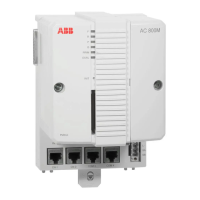Section 3 Parameter Interface Parameters for Alarm Handling
3BSE042835-600 39
The reverse attribute can be used for components in the data types used in
communication variables for point-to-point communication. If there is any reverse
component in a communication variable, it is communicated from out backwards to
in (opposite direction to the normal data flow). This also implies that it is only
allowed to communicate one-to-one (an out communication variable can be
connected to only one in communication variable if the data type with the reverse
component is used).
Handling Communication Failure using ISP Value
The data type editor contains the column to define an ISP value to each component.
These ISP values will be used in case of communication failure.
The rest of the components, which do not have any ISP values, will keep the
existing value.
For safe communication using IAC in a SIL application ISP value must be defined
for all components in a data type and for safe MMS it is on the user responsibility to
arrange for safe values if the communication is broken.
Parameters for Alarm Handling
The alarm handling in object should be unified with possibility to assign class,
severity, condition name, alarm and event configuration, as well as possibility to
inhibit and disable alarms. Therefore, a number of parameters defined in Table 13
on page 98, have been reserved for this purpose.
Monitoring Continuous Execution
The parameters used for control of continuous functionality (for example, level
monitoring) are described in Table 7. All of these parameters need not be defined at
all times. If Error or Warning is defined, Status must also exist. If Error and
Warning occur simultaneously, the error status code shall be given in Status.
For function block types, Error and Warning only last for one invocation. For
control module types, Error and Warning are active for as long as the invocation
lasts.
Add a suffix (for example, EnableReport, ErrorReport) in case of several activation
signals.

